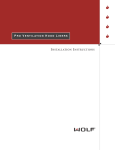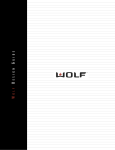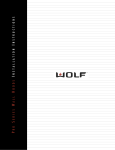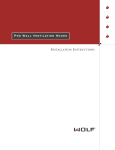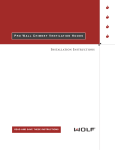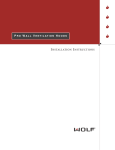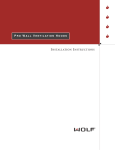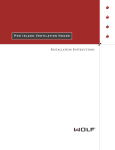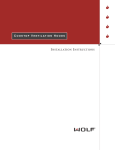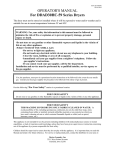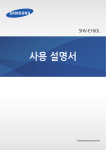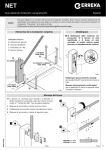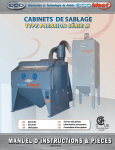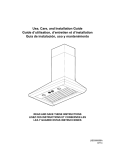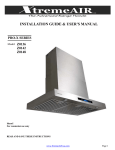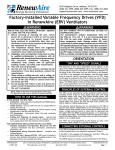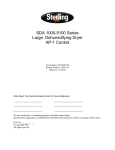Download Wolf L582212 Specifications
Transcript
P R O S E R I E S H O O D L I N E R S I N S T A L L A T I O N I N S T R U C T I O N S I M P O R T A N T I N F O R M A T I O N IMPORTANT NOTE: This installation must be completed by a qualified installer or service agency. Before you begin installation, read these instructions completely and carefully. • INSTALLER: please retain these instructions for local inspector’s reference, then leave them with the homeowner. • Please read the entire installation instructions prior to installation. • HOMEOWNER: please read and keep these instructions for future reference. • Please read the entire Wolf Pro Series Ventilation Use & Care Information book prior to use. As you follow these installation instructions, take particular note of the CAUTION and WARNING symbols when they appear. This information is important for the safe and efficient installation of the Wolf Pro Series Ventilation Hood Liner. CAUTION signals a situation where minor injury or product damage may occur if you do not follow instructions. WARNING states a hazard that may cause serious injury or death if precautions are not followed. In addition, the printed instructions may signal an IMPORTANT NOTE, which highlights information that is especially important for a problemfree installation. IMPORTANT NOTE: This appliance must be installed in accordance with National Electrical Codes, as well as all state, municipal and local codes. The correct voltage, frequency and amperage must be supplied to the appliance from a dedicated, grounded circuit which is protected by a properly sized circuit breaker or time delay fuse. The proper voltage, frequency, and amperage ratings are listed on the product rating plate. Record the model and serial numbers before installing the ventilation hood liner. Both numbers are listed on the rating plate, located on the left wall of hood liner shell. Model # Serial # If you have questions concerning the installation of this product, call Wolf Appliance Company, LLC at (800) 332-9513. If you received a damaged ventilation hood liner you should immediately contact your dealer or builder. 2 P R O S E R I E S V H E N T I L A T I O N L I N E R S 223/8" (568 mm) (305 mm) O O D FEATURES • Available for 30", 36", 42", 48", 54" and 60" ventilation hood shells • (I) models include 600 cfm internal blower • Recessed controls 12" 4" (102 mm) 12" (305 mm) • Halogen lighting with night-light • Stainless steel enclosed liner 28 3/8" (721 mm) 22 1/2" (572 mm) • Stainless steel baffle filters • Transition included Pro-Series Hood Liner Overall Dimensions (Model L282212I) • Internal or remote blower option • Heat Sentry feature • Top discharge TOP WIDTH • Damper included 12" (305 mm) 4" (102 mm) 12" 1" (305 mm) (25 mm) 22 1/2" BOTTOM WIDTH (572 mm) Pro-Series Hood Liner Top Width Overall Dimensions (28-3/8", 34-3/8", 40-3/8", 46-3/8" and 52-3/8"Width ) Pro-Series Hood Liner Bottom Width Overall Dimensions (34-3/8", 40-3/8", 46-3/8", 52-3/8" and 58-3/8" Width ) 3 P R O S E R I E S V E N T I L A T I O N H O O D L I N E R S INSTALLATION CONSIDERATIONS 1) A straight, short duct run will allow the hood liner to perform more efficiently. Try to limit the number of elbows and transitions to as few as possible. Long duct runs, elbows and transitions will reduce the performance of the hood liner. IMPORTANT NOTE: All hoods must exhaust to the outdoors. IMPORTANT NOTE: There is a possibility of noise issues, if there is a short duct run coupled with a remote blower. 2) Always use metal ducting. Do not use flex ducting. 3) Wolf recommends installing a back-draft damper in all installations (included with hood liner). In cold weather installations a back-draft damper is necessary to minimize the backflow of cold air into the room. 4) Wolf recommends the hood liner be installed 30" to 36" above the cooking surface. 5) Local building codes may require the use of make-up air. Consult your local HVAC professional for specific requirements in your area. DUCTWORK INSTALLATION THROUGH ROOF ROOF CAP TOP DISCHARGE* 10" ROUND DUCT TRANSITION SOFIT OR CABINET OR DUCT COVER DECORATIVE HOOD 12" (305 mm) HEIGHT OF LINER 30" TO 36" (762 mm - 914 mm) COOKING SURFACE TO BOTTOM OF HOOD LINER HOOD LINER 22 1/2" (572 mm) DEPTH OF LINER 37" (940 mm) TO COOKING SURFACE WARNING To reduce the risk of fire and electric shock, install this hood liner only with the blowers manufactured by Wolf Appliance Co., Model numbers 805087, 805347, 801640, 801641, 801642 and 804701. *TOP DISCHARGE ONLY FOR VENTILATION HOOD LINERS Liner Installation Dimensions 4 Decorative Hoods A decorative hood can be created out of wood, plaster, tile or metal. The height of the liner does not have to be the same as the height of the decorative hood, and is generally shorter. The decorative hood and Wolf liner must fit at the bottom edge in both width and depth. The shape of the decorative hood is not critical, the only place where the the liner and outside cover must meet is at the bottom edge of the metal liner. Wood hoods are rarely square. Always measure inside depth and width dimensions in multiple locations and use the smallest dimensions to verify liner specifications. The bottom depth and the bottom width of the Wolf liner must meet and fit with the bottom interior of the decorative hood. LOCATION OF ELECTRICAL 6" (152) DECORATIVE HOOD Always use the interior measurements of the decorative hood and measure in multiple places. The top depth of the liner (12" standard) must be less than the interior depth of the hood. You must measure the interior depth of your hood at the top height of the liner to make sure the liner will fit inside of the decorative hood. The Wolf liner comes standard with a 4" lower reveal. Be sure to include this dimension in your decorative hood selection. 2" x 4" FRAMING #10 SCREW WOOD HOOD LINER #10 SCREW 1/2" THICK DRYWALL Installation Cross-Section E 5" (127) HOOD LINER DECORATIVE HOOD 12" (305) HEIGHT OF LINER HOOD LINER WIDTH OF LINER 30" TO 36" (762 - 914) TO COOKING SURFACE 30" TO 36" (762 - 914) TO COOKING SURFACE 22 1/2" (572) DEPTH OF LINER COOKING SURFACE NOTE: Dimensions in parentheses are in millimeters. Cabinetry and Electrical Placement 5 P R O S V E R I E S E N T I L A T I O N H O O D L I N E R S INSTALLATION CONSIDERATIONS Shipping Weights for Hood Liners Model Number Shipping Weight L282212I 57 lbs. L342212 46 lbs. L402212 52 lbs. L462212 57 lbs. L522212 65 lbs. L582212 72 lbs. Installation Dimensions Refer to the following illustration and chart for critical dimensions needed for the proper installation of the ventilation hood liner. B HEIGHT OF TRANSITION CL TO CENTER OF TRANSITION D CL C TO CENTER OF TRANSITION A WIDTH OF LINER Shipping Weights for Blowers Blower Part Shipping Number Weight LBLOWER-120INT 805087 38 lbs. CTBLOWER-60REM 801640 35 lbs. Model Number Width of Liner (A) Height of Transition (B) To Center of Transition (C) To Center of Transition (D) CTBLOWER-90REM 801641 35 lbs. L282212I 28 3/8" (721) 7 1/2" (191) 14 3/16" (360) 4 11/16" (119) 9 1/2" 17 3/16" (437) 5 13/16" (148) CTBLOWER-120REM 801642 39 lbs. L342212 34 3/8" CTBLOWER-150REM 804701 47 lbs. L402212 40 3/8" (1026) 9 1/2" (241) 20 3/16" (513) 5 13/16" (148) L462212 46 3/8" (1178) 9 1/2" (241) 23 3/16" (589) 5 13/16" (148) L522212 52 3/8" (1330) 9 1/2" (241) 26 3/16" (665) 5 13/16" (148) L582212 58 3/8" (1483) 9 1/2" (241) 29 3/16" (741) 5 13/16" (148) Hardware Contents: (873) (241) NOTE: Dimensions in parentheses are in millimeters • (10) #10 screws self tapping hex head 2" long • (10) 10-24 hex head flanged nuts 6 INSTALLATION Step 2: Wall Preparation 7 1/2" 16 3/4" WARNING Framing must be structurally tied together and tied to ceiling joists to provide enough strength to support the weight of the hood liner and the internal blower, if applicable. 8" ROUND CL 3 1/4" 7 1/16" * 31/4" * 16 5/8" 11/16" IMPORTANT NOTE: Do not use duct smaller than 8" round. IMPORTANT NOTE: Wolf recommends that the hood liner be installed a minimum of 30" and a maximum of 36" above the cooking surface. 1 3/16" CL * DIMENSION IS 2" Mounting for Model L282212 1) Construct wood wall framing that is flush with the interior surface of the wall studs. Make certain that the framing is centered over the desired installation location. 91/2" 21 1/4" 2) Use the rough-in plate shipped with the liner to determine framing location. 3) After wall surface is finished, secure the rough-in plate to the wall surface. NOTE: If additional mounting holes are required for adequate liner support, drill additional mounting holes in rough-in plate and use these holes to attach liner assembly to wall framing. 161/2" * 31/4" CL 10" ROUND 8 1/2" * 51/2" * * 22 3/8" 10 13/16" 1" * * 61/2" 51/2" * * CL * DIMENSION IS 2" * 61/2" Mounting for Models L342212, L402212, L462212, L522212 and L582212 7 P R O S E R I E S V E N T I L A T I O N H O O D L I N E R S INSTALLATION Step 3: Hood Liner Preparation If installing LBLOWER-120INT (805087), see installation for internal blower on page 11. IMPORTANT NOTE: Wolf recommends installing the internal blower to the rough-in plate assembly prior to installing liner to the wall framing. 1) The liner assembly is shipped with the rough-in plate and the transition attached. The transition is shipped upside down in the top of the liner assembly and must be removed and reinstalled. 2) Detach the rough-in plate / transition from the liner assembly by removing the four (4) screws on the top and the four (4) screws on the back of the rough-in plate / transition assembly. 3) Detach the transition from the rough-in plate by removing the four (4) screws. DO NOT DISCARD SCREWS. Shipping screws are needed for reinstallation of transition to the rough-in plate. 8 4) Attach transition to existing ductwork with sheet metal screws. Use duct tape or silicone to make all joints secure and air tight. 5) If installing a remote blower, drill 7/8" hole through the wood framing for conduit wires. See Connect Remote Blower on page 12 for overall dimensions and electrical requirements. See installation instructions provided with blower for mounting and installation information. IMPORTANT NOTE: Do not run remote blower connects through ductwork. 6) If installing internal blower LBLOWER-120INT (805087) see installation guidelines on page 11 and installation instructions provided with blower. ROUGH-IN PLATE SHIPPING SCREWS TRANSITION HOOD ASSEMBLY Rough-in Plate Installation Step 4: Install the Rough-In Plate Step 5: Install the Hood Liner 1) Use rough-in plate assembly to determine stud locations. 1) Align both ends of the liner assembly with the ends of the roughin plate. 2) Install #10 x 2" screws through rough-in plate into wall framing. CAUTION If wall framing is not available, wall anchors must be used. 3) If additional mounting holes are required for adequate liner support, drill additional mounting holes in rough-in plate and use these holes to attach rough-in plate assembly to wall framing. SOFFIT ROUGH-IN PLATE 2) Insert the back ends of the liner assembly into the rough-in plate and push the liner assembly toward the wall. CAUTION MOUNTING HOLES Note the weight of the hood liner. Three people may be required for proper installation. Hood Liner Installation 3) Using the hex nuts provided with rough-in plate, secure the liner assembly to the rough-in plate. 4) Install remaining #10 x 2" screws in the lower section of the liner. Verify that wall studs or framing are engaged. Wall anchors are required if the screws will not hit the wall stud. 9 P R O S E R I E S V E N T I L A T I O N H O O D L I N E R S INSTALLATION Step 6: Install Wiring WARNING This ventilation hood liner must be properly grounded. This unit should be installed by a qualified electrician in accordance with all applicable national and local electrical codes. WARNING Before servicing or cleaning unit, switch power off at service panel and lock the service disconnecting means to prevent power from being switched on accidentally. When the service disconnecting means cannot be locked, securely fasten a prominent warning device, such as a tag, to the service panel. 1) Run 120 VAC, 15 amp (minimum) circuit electrical power cable from the service panel to the junction box in the rough-in plate. 2) Remove the knock-out and install the conduit connector on the roughin plate hole. 3) Feed the conduit through the hole on top of the rough-in plate to the junction box. 4) Remove the junction box cover from the rough-in plate. Connect black wire to power supply black wire, white wire to power supply white wire and green wire to green wire or bare wire. 5) Place all wiring connections inside junction box and re-install on roughin plate. Make sure that wires are secure and that no wires are pinched between cover and box. 2" 2 1/2" 2 1/2" Electric Placement 10 Wiring Diagram Refer to the wiring diagram packaged with the liner for more information. Step 7: Install Hood Liner Filters and Drip Cups 1) Remove all packaging material from filters and drip cups. 2) Slide drip cups along bottom edge of liner opening so lip overhangs slightly. 3) Lift filters into place. Lines of filters must run vertically and align with drip cups. 4) Adjust filters to fill space by sliding filters left to right. V E N T I L A T O R I N S T A L L A T I O N INTERNAL BLOWER IMPORTANT NOTE: Before turning the power on, make sure the blower is in the "OFF" position. Use wire connectors or wire nuts approved by UL or C/UL. Refer to installation instructions provided with each blower to verify wall or roof cut-outs. LBLOWER-120INT (805087) Installation IMPORTANT NOTE: Wolf recommends installing the internal blower to the rough-in plate assembly prior to installing liner to the wall framing. 5) Once hood liner installation is complete, plug blower power cord(s) into receptacle(s) located near the center of the hood liner shell. Use clips on liner interior to keep excess power cord away from moving parts. 1) Slide blower mounting tab into liner rough-in plate mounting slot. Make sure blower tab and mounting slot are aligned properly front to back. 2) Secure blower with 1/4-20 weld stud at back of blower and liner rough-in plate with 1/4 nut supplied with blower. 3) Verify that blower discharge aligns with liner back-plate discharge cutout. 4) Once the blower is attached to the liner rough-in plate, install the liner rough-in plate to the wall. Be sure to secure power cord(s) so as not to damage or pinch while installing liner shell. WELD STUD MOUNTING SLOT MOUNTING TAB HOOD ROUGH-IN PLATE BLOWER HOUSING Internal Blower Installation 11 V E N T I L A T O R I N S T A L L A T I O N REMOTE BLOWER IMPORTANT NOTE: Before turning the power on, make sure the blower is in the "OFF" position. Use wire connectors or wire nuts approved by UL or C/UL. Refer to installation instructions provided with each blower to verify wall or roof cut-outs. STEP 1: Plan the Installation 1) Locate the blower so the length of the duct run and number of elbows and transitions are kept to a minimum. 2) Where possible, blower should be located between wall studs or roof rafters. 3) Avoid pipes, wires or other ductwork that may be running through the wall. 4) Be sure that there is enough space for any transitions that may be needed between the blower and the connecting ductwork. 5) For best performance, locate transitions nearest the blower. STEP 2: Connect Remote Blower NOTE: Always refer to all blower installation instructions provided with the blower for additional mounting and wiring instructions. 1) Remove cover from wiring box inside of liner shell. Remove wiring box knockout. 2) Feed 6” of inbound power cable through the knockout opening hole and into the wiring box. Secure the cable to wiring box with an appropriate connector for type of cable being used. Connect leads as follows: • Black (L1) to black (loose) in the J box from the switch. • Neutral to neutral (loose) in the J box from the switch. 3) Wiring Remote Blower: Follow wiring instructions at the blower as outlined in the particular blower installation instructions. Black (L1) to black, white (neutral) to white – or white to blue, or white to brown (depending on model) and green to grounding screw. Run remote blower cable (ROMEX) to the liner. Feed 6” of ROMEX through the knockout opening hole and into the wiring box on the rough-in plate of liner. Secure the cable to wiring box with an appropriate connector. Locate cord assembly provided with the remote blower. The cord assembly has two leads, black (L1) and white (neutral). Connect these leads to the leads from the blower, black to black and white to white. Connect ALL green and bare wires together to the ground screw in the wiring box. 4) Plug cord assembly into receptacle located near the center of the liner shell. Use clips on liner interior to keep excess power cord away from moving parts. 5) Re-install wiring box cover and screws. Make sure all wires are secure and that no wires are pinched between cover and box. 21"(533) 18"(457) 20 3/4"(527) 28 1/4"(717) 29 1/2"(749) 29 1/2"(749) 10"(254) 10"(254) 10"(254) DIAMETER 10"(254) 10"(254) DIAMETER DIAMETER 15 1/2"(394) 24 1/2"(622) 14"(356) 4 3/4"(121) 14 3/4"(375) 29 1/2"(749) 22"(559) Remote Blower Dimensions-600CFM (801640) and 900CFM (801641) 12 29 1/2"(749) 10 3/8"(264) 101/8"(257) 24 3/4"(629) 14 3/4"(375) 7 1/4"(184) Remote Blower Dimensions-1200CFM (801642) 25"(635) 7 1/4"(181) Remote Blower Dimensions-1500CFM (804701) P R O S E R I E S V E N T I L A T I O N H O O D L I N E R BLOWERS C C E S S O R I E S BACKSPLASHES Internal Blowers Remote Blowers • 805347 – 600 CFM internal blower factory installed with Model L282212I. • CTBLOWER-60REM (801640) – 600 CFM remote blower for ventilation hood liners (except Model L282212I). • LBLOWER-120INT (805087) – 1200 CFM internal blower for 34-3/8", 40-3/8", 46-3/8", 52-3/8" and 58-3/8" wide ventilation hood liners. A • CTBLOWER-90REM (801641) – 900 CFM remote blower for ventilation hood liners (except Model L282212I). • CTBLOWER-120REM (801642) – 1200 CFM remote blower for ventilation hood liners (except Model L282212I). • CTBLOWER-150REM (804701) – 1500 CFM remote blower for ventilation hood liners (except Model L282212I). For blower specifications, refer to the Ventilation Recommendations charts found in the Wolf Design Guide. Stainless steel backsplashes are available in the following sizes for all Wolf wall ventilation hoods and liners. • 30BAK/DF – 30"W x 38"H backsplash for 30" wall hoods. • 36BAK/DF – 36"W x 38"H backsplash for 36" wall hoods. • 42BAK/DF – 42"W x 38"H backsplash for 42" wall hoods. • 48BAK/DF – 48"W x 38"H backsplash for 48" wall hoods. • 54BAK/DF – 54"W x 38"H backsplash for 54" wall hoods. • 60BAK/DF – 60"W x 38"H backsplash for 60" wall hoods. • 66BAK/DF – 66"W x 38"H backsplash for 66" wall hoods. 13 I M P O R T A N T I N F O R M A T I O N SERVICE INFORMATION IMPORTANT NOTE: If the ventilation hood liner does not operate properly, follow these troubleshooting steps: • Verify that power is being supplied to the ventilation hood liner. • Check the electrical connections to ensure that the installation has been completed correctly. • If the ventilation hood liner still does not work, contact an authorized Wolf Factory Authorized Service Center. Do not attempt to repair the ventilation hood liner yourself. Wolf is not responsible for service required to correct a faulty installation. • To obtain the name and number of a Wolf Factory Authorized Service Center, call Wolf Customer Service at (800) 332-9513 or check our website; www.wolfappliance.com. • When calling for service, you will need the ventilation hood liner model and serial numbers. Both numbers are listed on the rating plate, located on the left wall of hood liner shell. 14 The information and images are the copyright property of Wolf Appliance Company, LLC, an affiliate of Sub-Zero Freezer Company, Inc. Neither this book nor any information or images contained herein may be copied or used in whole or in part without the express written permission of Wolf Appliance Company, LLC, an affiliate of Sub-Zero Freezer Company, Inc. ©Wolf Appliance Company, LLC all rights reserved. W OLF A PPLIANCE C OMPANY, LLC P. O. Box 44848 • Madison, WI 53744 • 800-332-9513 www.wolfappliance.com 805049 REV-C 9/03
















